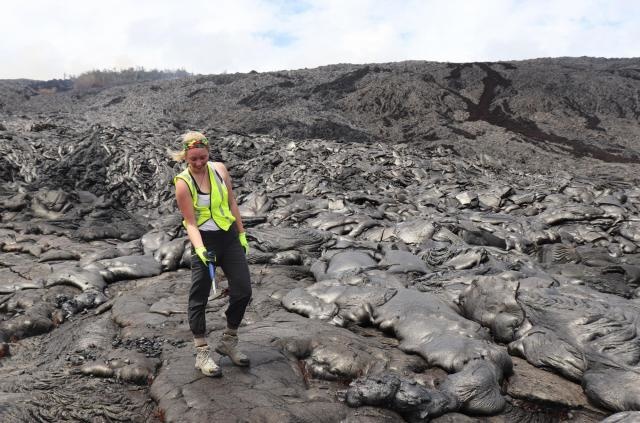
Geology student Allison Kusick walks along a lava field. Undergraduate students at the University of Iowa traveled to Hawaii and studied the Kilauea volcano just two months before it erupted on May 3. The group made the trip to learn about Earth processes alien to the Midwest; the students christened their rock hammers by dipping them in the lava. Photo courtesy of Kate Tierney.
By Richard Lewis, Iowa Now
University of Iowa geology students had a close brush with history—and a unique hands-on learning experience—that they likely never will forget.
Just two months before the Kilauea volcano in Hawaii began erupting on May 3—making news worldwide with an earthquake and lava flows that torched forests, engulfed roads and homes, and spewed toxic fumes—UI students visited the volcanic complex to learn about and study its features. Under the supervision of experienced UI faculty geologists, the students explored a region that was quiet at the time, yet hardly dormant, witnessing an active eruption and dipping their rock hammers into molten rock so hot it risked singing the hair on their arms.
“We were very close to where Kilauea erupted,” says Brittany Stolfus, a senior geosciences major from Freeport, Illinois. “You walk around and you look at past features, and you’re like, ‘That’s cool,’ and then eruptions are happening months later. It gives you an idea that this geological activity is ongoing and is actively forming volcanic features. It helps you understand it a lot more.”
Kilauea is a crater in Hawaii Volcanoes National Park, located on the island of Hawaii (also called the Big Island). It, along with park neighbor Mauna Loa, has been erupting regularly for decades, although most of the eruptions have been modest and posed little threat.
Molten rock peeks through the crust of a lava field. Photo courtesy of Allison Kusick.
That changed in early May, when underground flows of molten rock, known as magma, ripped fiery fissures into the Earth along the east side of Hawaii Volcanoes National Park, like a series of stitches that suddenly burst open. Across the park, ash plumes erupted and lava flows snaked like red-hot rivers across the terrain. The see-saw flow of underground magma triggered a 6.9 magnitude earthquake on May 4 and, two weeks later, an ash plume that rose 30,000 feet above sea level.
The students and their faculty leader, Kate Tierney, in the UI Department of Earth and Environmental Sciences, traveled to Hawaii to explore geology alien to Iowa and the Midwest. The purpose, Tierney says, was at least two-fold: Introduce aspiring geologists to terrestrial processes they hadn’t seen before and add a real-life, in-place experience to complement what they have learned in the classroom.